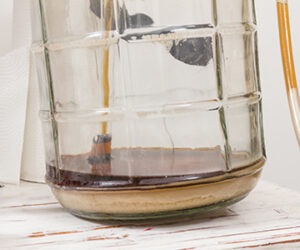Open Fermentation: Tips from the Pros
Before the days of airlocks and cylindroconicals, open fermenters were the only way to go. These days, however, despite all the modern methods, some brewers believe that the old way is still the best way. Take some advice from these U.S. brewers about this time-honored technique.
Brewer: Ron Jeffries, Jolly Pumpkin Artisan Ales in Dexter, MI
With open fermentation, your fermenter isn’t just open, it also calls for a certain geometry of the tank. Our open fermenters have a shallower height to diameter ratio, which is 1:1. This shape tends to create different flavor esters because of the way the yeast behaves. I think that this type of fermentation makes for superior beers.
A lot of breweries switch to cylindroconical fermenters that are closed, not necessarily to make better beers, but because they can make larger batches and the fermenters are easier to clean. I know, though, that when some breweries switched, such as Orval, that certain measures were taken to try and preserve as many flavor characteristics as possible – because there are differences. That doesn’t mean that open fermentation is abandoned, though. I think that open fermenters are probably tucked away in breweries all over the world.
The benefit of open fermentation is the flavors you can create. There are ester profiles that are more complex. In lagers, the esters can even be too much for some people, but I think they’re fantastic. Also, beer from an open fermenter is less likely to absorb sulfur aromas as you can’t off gas as easily as you can in a cylindroconical. Top cropping yeast is also superior in open fermentation, and you can harvest a much healthier yeast crop.
Another positive aspect is that open fermentation requires a secondary vessel for aging. While this might be more labor intensive and requires more vessels as opposed to leaving beer in a cylindroconical, you can actually make more beer because your primary fermenters aren’t tied up as long.
At home, the same conditions as commercial brewing are true – especially a clean brewing environment. Find a spot that can be as free of dust as possible and definitely away from any pet hair. You really don’t want to worry about stuff falling into the beer. Use a stainless steel pot or plastic bucket that has a loose fitting lid to let gas escape, but otherwise the normal fermenting procedure is exactly the same as if you were brewing in a closed fermenter.
Brewer: Ollie Lagomarsino, Anchor Brewing Company in San Francisco, CA
At Anchor, open fermentation is all about tradition. In the 1800’s, steam beer was brewed by open fermenters without refrigeration. When Fritz Maytag bought the brewery, he felt that continuing open fermentation was the right thing to do.
Our primary fermenters are very shallow pans that allow the heat to dissipate faster. In the old days, to cool the boiled wort down, brewers would pump it into huge vats on the roof of the building called brewships, which would use the cool San Francisco air to cool them down, which of course wasn’t very sanitary. I personally think that is how Anchor Steam got its name – from the steam coming off of the roof.
Although we don’t have to make Anchor Steam the way that we do, I don’t see that there’s many pitfalls to making it that way except for capturing the CO2 during primary fermentation for carbonation. In our case, however, the beer is carbonated with natural kräusening.
As for open fermentations at home, I’ve never homebrewed, so I really can’t say if I think it’s possible, but I think it’s feasible if you are careful about your brewing environment. At Anchor, we pump positive fed air into the rooms with the open fermenters to prevent any yeast contamination. If you brew a lot, mingling yeasts may be a problem, so like us you should keep all your yeasts separated. For example, we keep our ale yeast in a different part of the brewery than our lager yeast. We also wash our yeasts with acid periodically to prevent different strains from getting involved.
Brewer: David Geary, D.L. Geary Brewing Company in Portland, ME
The major benefit of open fermentation, for us, is yeast management. Whereas a closed fermentation in a cylindroconical fermenter might yield six or so generations of yeast, we have done about 5,000 generations in our Yorkshire round-style open fermenters. With this style of fermentation, the yeast is constantly cleansing itself at the top of the tank, turning over things like hops residue, which drops to the bottom while the healthy yeast linger at the top. In a cylindroconical, the yeast you harvest is at the bottom along with the residue.
There are some drawbacks to open fermentation, but if you have the right yeasts you can overcome a lot of common misconceptions about airborne yeasts, bacteria and contaminants like fruit flies. At D.L. Geary, not much can compete with our healthy yeast strain. The pH is very low and unfavorable to bacteria, and the layer of CO2 on the top is a very effective biological lid — even fruit flies know not to go where they can’t breathe.
If your yeast isn’t vibrant enough, I don’t think you would want to open ferment. We use a combination of a fast starter and a strong flocculator, which are very dense. Anything otherwise might expose the beer to air. Our primary fermentation lasts around three days. After that we chill the beer down in the fermenters with glycol-filled coils and allow the beer to continue to condition in the fermenters for another five to six days. Around this time the yeast forms an extremely dense lid, which protects the beer underneath.
For homebrewing, I’ve heard of fermenting in a large stock pot with a lid, which is probably the way to go. I dare say, however, that most yeasts available to homebrewers, especially dry yeasts, may not have the right stuff to be successful, especially when a lot of homebrewers are doing open fermentations in cellars with mold and such. Also, yeast management is, in my opinion, one of the biggest benefits on a commercial scale, but at the homebrewing level I don’t think it makes much of a difference.
Brewer: Steve Dresler, Sierra Nevada in Chico, CA
When I started at Sierra Nevada, we only had open fermentation in our cellar, 5-barrel (170-gal./645-L) batches. The brewery started with open fermentation because it was deemed as the most traditional way to do ale fermentation in open squares. I do feel that the ester notes from open fermentation are exceptional, and there is very little stress put on the yeast by CO2 saturation and hydrostatic pressures that you get in larger cylindroconical fermenters. We still have four 100-barrel (3,400-gal./12,900-L) fermenters at the brewery and use them all the time.
Also, when we were doing open fermentation only, or as a greater percentage of our production, I could run my yeast for many more generations without propagating because there is less stress on the yeast during fermentation.
The pitfalls are, of course, that you need to have a very clean fermentation environment (you should anyway), and watch your micro closely. We have sterile filtered air going into our fermenter room at a higher flow rate than the CO2 evacuation to try and cause a positive displacement situation.
Also with open fermenters you do need to have a secondary fermenter to transfer the beer into. This is an additional cost and takes up more real estate than doing the entire fermentation in a single unitank. Open fermenters also do not lend themselves to automatic Clean-in-Place (CIP) processes and have to be manually cleaned, which takes more time and labor.
After primary fermentation, the beer needs to be moved into the secondary tank. This should be done when there is still a small amount of extract left in the beer so that at the end of fermentation the yeast can take up any oxygen that the beer comes in contact with during the transfer. It is nice to purge or at least blanket the secondary fermenter with CO2 prior to moving the beer. This is also a perfect time to dry hop the beer if that is a desired effect.
I suppose open fermentation would be fine at home, but it should be attempted in a closed environment such as a cooler or temperature controlled box that can be properly sanitized.



